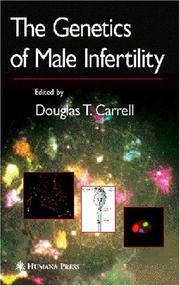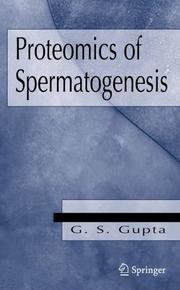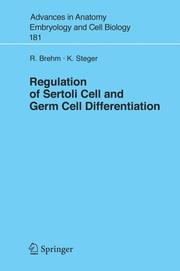| Listing 1 - 8 of 8 |
Sort by
|

ISBN: 1280832541 9786610832545 1597451762 1588298639 Year: 2007 Publisher: Totowa, N.J. : Humana Press,
Abstract | Keywords | Export | Availability | Bookmark
 Loading...
Loading...Choose an application
- Reference Manager
- EndNote
- RefWorks (Direct export to RefWorks)
Infertility is a common and severe health problem affecting roughly 7% of the male population. It is likely that the majority of those patients have genetic abnormalities that are the cause of their infertility. In The Genetics of Male Infertility, twenty-one researchers and clinicians review the study of the genetics of male infertility, the tools available in the laboratory and clinic, the current state of knowledge, and the future of research and translation into clinical diagnostics and treatments. This volume gives special attention to the significant technological advances in the treatment of male infertility, including intracytoplasmic injection (ICSI) in conjunction with in vitro fertilization (IVF). In addition, new tools discussed include in vitro methodologies, in silico technologies, and new model organisms. Providing a review of our current understanding of genetic causes of male infertility, The Genetics of Male Infertility serves as a guide to evidence-based clinical applications, and a preview of future possibilities.
Infertility, Male --- Spermatogenesis --- Genetic aspects --- Formation of spermatozoa --- Spermatozoa --- Gametogenesis --- Male infertility --- Male sterility --- Sterility, Male --- Generative organs, Male --- Infertility --- Formation --- Diseases
Periodical
Abstract | Keywords | Export | Availability | Bookmark
 Loading...
Loading...Choose an application
- Reference Manager
- EndNote
- RefWorks (Direct export to RefWorks)
Spermatogenesis --- Cellular control mechanisms --- Cellular control mechanisms. --- Genetic aspects --- Genetic aspects. --- Genetics --- Cell regulation --- Biological control systems --- Cell metabolism --- Formation of spermatozoa --- Spermatozoa --- Gametogenesis --- Formation --- Spermatogenesis. --- Spermatocytogenesis --- Spermiogenesis

ISBN: 1281087238 9786611087234 0387276556 038725398X Year: 2005 Publisher: New York, NY : Springer,
Abstract | Keywords | Export | Availability | Bookmark
 Loading...
Loading...Choose an application
- Reference Manager
- EndNote
- RefWorks (Direct export to RefWorks)
Recent developments of experimental techniques in cellular and molecular biology have made it possible to understand the molecular biology of male gametogenesis in greater detail. This book focuses on the description of specialized proteins, which are dominantly and/or specifically expressed in germ cells and localized in spermatozoa. There is an urgent need to classify proteins of spermatogenic cells with a view of their functions, and their applications in the regulation of fertility and in understanding infertility. The understanding of structural properties of male germ cell specific proteins can offer vulnerable points for targeted intervention in testis without generalized effects on stages of spermatogenesis. Besides targeted action in male germ cells, sperm specific proteins and polypeptides may also offer potential application in the development of a contraceptive vaccine. Researchers in the fields of biochemistry, cell biology, molecular biology, reproductive biology and proteomics will find this book of interest. "This book is far superior to any previous book on the subject. I recommend this book with great enthusiasm." Pawan K. Singal St. Boniface General Hospital Research Center .
Spermatogenesis. --- Proteomics. --- Molecular biology --- Proteins --- Formation of spermatozoa --- Spermatozoa --- Gametogenesis --- Formation --- Cytology. --- Cell Biology. --- Cell biology --- Cellular biology --- Biology --- Cells --- Cytologists --- Cell biology. --- Proteins. --- Protein Biochemistry. --- Proteids --- Biomolecules --- Polypeptides --- Proteomics
Book
ISBN: 2804122638 9782804122638 Year: 1996 Publisher: Bruxelles: De Boeck,
Abstract | Keywords | Export | Availability | Bookmark
 Loading...
Loading...Choose an application
- Reference Manager
- EndNote
- RefWorks (Direct export to RefWorks)
Comment le spermatozoïde et l'œuf interagissent-ils pour former un nouvel organisme? Comment une seule cellule donne-t-elle naissance à tous les types cellulaires d'un organisme adulte? Comment les neurones arrivent-t-ils à établir leurs connexions avec les autres neurones et les tissus périphériques? Comment se forment les organes? Autant de questions qui montrent le rôle éminent de la biologie du développement car elle intègre toutes les facettes de la biologie et joue le rôle crucial d'établir une relation entre génotype et phénotype. On peut étudier ainsi le développement à partir de n'importe quel organisme et à n'importe quel niveau d'organisation, de la molécule à l'espèce. La nouvelle édition de Biologie du développement a été profondément remaniée pour intégrer les acquis de la révolution génétique. Elle comporte notamment trois chapitres d'introduction qui exposent les données de base sur l'analyse génétique et sur les membranes cellulaires. les chapitres consacrés à la génétique du développement précèdent ceux qui examinent la spécification des axes de l'organisme et la détermination des premiers types cellulaires. En outre, pour respecter les approches biologiques et moléculaires, certaines frontières séparant la biologie du développement et ses disciplines connexes, comme la biologie de l'évolution et la génétique, ont été abolies.
Biologie --- Developmental Biology --- Embryology --- Developmental biology --- Biologie du développement --- Embryologie --- ontwikkelingsbiologie --- biologie du développement --- Biologie du développement --- Developmental Biology. --- Embryology. --- Gametogenesis --- Biological development --- Morphogenesis --- Fecundation --- Embryonic development --- Organogenesis --- Animals --- Development --- Cleavage stage, Ovum --- Cell differentiation --- Fertility --- Cells --- Cell recognition --- Genetics --- Interactions

ISBN: 1280346833 9786610346837 3540294465 3540257500 Year: 2005 Publisher: Berlin : Springer,
Abstract | Keywords | Export | Availability | Bookmark
 Loading...
Loading...Choose an application
- Reference Manager
- EndNote
- RefWorks (Direct export to RefWorks)
Unwanted childlessness affects approximately one in six couples worldwide. - though the exact proportion of the predominant cause of the problem remains controversial, according to the World Health Organization (WHO), in nearly 40% of cases the cause can be attributed to the female, in 20% to the male, in 25% to both, and in 15% the cause remains unknown. Based on these ?gures, the - cidence of male factor infertility in the general population is approximately 7%. The majority of these men, approximately 30%, experience irreversible idiopathic infertility and cannot father children without some form of medical intervention. Male factor infertility, in addition, may be caused by testicular germ cell cancer, which is known to represent the most common cancer among young men, aged 15 to 35 years, in Western industrialized countries. The number of affected men has increased dramatically over the past 50 years. There is now growing evidence that human testicular germ cell cancer originates from fetal germ cells exhibiting an aberrant programme of gene expression, and tumour progression may be favoured by an aberrant Sertoli cell-germ cell communication.
Sertoli cells. --- Germ cells. --- Spermatogenesis. --- Infertility, Male. --- Male infertility --- Male sterility --- Sterility, Male --- Generative organs, Male --- Infertility --- Formation of spermatozoa --- Spermatozoa --- Gametogenesis --- Gametocytes --- Germ-line cells --- Germline --- Reproductive cells --- Sex cells --- Cells --- Germplasm resources --- Cells of Sertoli --- Sertoli's cells --- Sustentacular cells --- Testis --- Diseases --- Formation --- Medicine. --- Biomedicine general. --- Clinical sciences --- Medical profession --- Human biology --- Life sciences --- Medical sciences --- Pathology --- Physicians --- Health Workforce --- Biomedicine, general. --- Medicine --- Biology --- Biomedical Research. --- Research. --- Biological research --- Biomedical research
Book
ISBN: 0387095977 3540095977 0387799907 1489981454 0387095969 Year: 1980 Publisher: Berlin : Springer,
Abstract | Keywords | Export | Availability | Bookmark
 Loading...
Loading...Choose an application
- Reference Manager
- EndNote
- RefWorks (Direct export to RefWorks)
In the past thirty years, significant advances have been made in the field of reproductive biology in unlocking the molecular and biochemical events that regulate spermatogenesis in the mammalian testis. It was possible because of the unprecedented breakthroughs in molecular biology, cell biology, immunology, and biochemistry. In this book entitled, Molecular Mechanisms in Spermatogenesis, a collection of chapters has been included written by colleagues on the latest development in the field using genomic and proteomic approaches to study spermatogenesis, as well as different mechanisms and/or molecules including environmental toxicants and transcription factors that regulate and/or affect spermatogenesis. The book begins with a chapter that provides the basic concept of cellular regulation of spermatogenesis. A few chapters are also dedicated to some of the latest findings on the Sertoli cell cytoskeleton and other molecules (e.g., proteases, adhesion proteins) that regulate spermatogenesis. These chapters contain thought-provoking discussions and concepts which shall be welcomed by investigators in the field. It is obvious that many of these concepts will be updated and some may be amended in the years to come. However, they will serve as a guide and the basis for investigation by scientists in the field.
Spermatogenesis. --- Testis --- Molecular aspects. --- Testes --- Testicle --- Endocrine glands --- Generative organs, Male --- Gonads --- Scrotum --- Formation of spermatozoa --- Spermatozoa --- Gametogenesis --- Formation --- 537.8 --- 537.8 Electromagnetism. Electromagnetic field. Electrodynamics. Maxwell theory --- Electromagnetism. Electromagnetic field. Electrodynamics. Maxwell theory --- Medicine. --- Molecular Medicine. --- Biomedicine general. --- Clinical sciences --- Medical profession --- Human biology --- Life sciences --- Medical sciences --- Pathology --- Physicians --- Molecular biology. --- Biomedicine, general. --- Health Workforce --- Molecular biochemistry --- Molecular biophysics --- Biochemistry --- Biophysics --- Biomolecules --- Systems biology
Periodical
ISSN: 13484400 09168818 Year: 1992 Publisher: [Tokyo] : Japanese Society of Animal Reproduction,
Abstract | Keywords | Export | Availability | Bookmark
 Loading...
Loading...Choose an application
- Reference Manager
- EndNote
- RefWorks (Direct export to RefWorks)
Reproduction --- Developmental biology --- Developmental Biology. --- Reproduction. --- Developmental biology. --- Voortplanting (biologie) --- Amphimixis --- Generation --- Pangenesis --- Procreation --- Development (Biology) --- Human Reproductive Index --- Human Reproductive Indexes --- Reproductive Period --- Human Reproductive Indices --- Index, Human Reproductive --- Indexes, Human Reproductive --- Indices, Human Reproductive --- Period, Reproductive --- Periods, Reproductive --- Reproductive Index, Human --- Reproductive Indices, Human --- Reproductive Periods --- Biology, Developmental --- Biology --- Life (Biology) --- Physiology --- Sex (Biology) --- Embryology --- Generative organs --- Theriogenology --- Growth --- Ontogeny --- Embryonic and Fetal Development --- Growth and Development --- Agriculture Sciences --- Agricultural Biotechnology --- Auxology --- gametogenesis --- early embryonic development --- placenta development --- implantation --- reproductive endocrine function --- reproductive organ development --- Reproducción --- Biología del desarrollo --- Biologie du développement
Periodical
ISSN: 21947961 21947953 Year: 2013 Publisher: Berlin : Springer-Verlag,
Abstract | Keywords | Export | Availability | Bookmark
 Loading...
Loading...Choose an application
- Reference Manager
- EndNote
- RefWorks (Direct export to RefWorks)
Plants --- Plants, Sex in --- Plant Physiological Processes. --- Reproduction. --- Genetic Processes. --- Plants, Genetically Modified. --- Plants, Sex in. --- Reproduction --- Gemmation (Botany) --- Plant reproduction --- GMO Plants --- Genetically Engineered Plants --- Genetically Modified Plants --- Plants, Transgenic --- Transgenic Plants --- Engineered Plant, Genetically --- Engineered Plants, Genetically --- GMO Plant --- Genetically Engineered Plant --- Genetically Modified Plant --- Modified Plant, Genetically --- Modified Plants, Genetically --- Plant, GMO --- Plant, Genetically Engineered --- Plant, Genetically Modified --- Plant, Transgenic --- Plants, GMO --- Plants, Genetically Engineered --- Transgenic Plant --- Genetic Concepts --- Genetic Phenomenon --- Genetic Process --- Genetic Processes --- Concept, Genetic --- Concepts, Genetic --- Genetic Concept --- Phenomena, Genetic --- Phenomenon, Genetic --- Process, Genetic --- Processes, Genetic --- Human Reproductive Index --- Human Reproductive Indexes --- Reproductive Period --- Human Reproductive Indices --- Index, Human Reproductive --- Indexes, Human Reproductive --- Indices, Human Reproductive --- Period, Reproductive --- Periods, Reproductive --- Reproductive Index, Human --- Reproductive Indices, Human --- Reproductive Periods --- Physiology, Plant --- Plant Physiologic Phenomena --- Plant Physiologic Phenomenon --- Plant Physiological Phenomenon --- Plant Physiological Process --- Plant Physiological Processes --- Plant Physiology --- Phenomena, Plant Physiologic --- Phenomena, Plant Physiological --- Phenomenon, Plant Physiologic --- Phenomenon, Plant Physiological --- Phenomenons, Plant Physiological --- Physiologic Phenomena, Plant --- Physiologic Phenomenon, Plant --- Physiological Phenomena, Plant --- Physiological Phenomenon, Plant --- Physiological Phenomenons, Plant --- Physiological Process, Plant --- Physiological Processes, Plant --- Plant Physiological Phenomenons --- Process, Plant Physiological --- Processes, Plant Physiological --- Sex in plants --- Flora --- Plant kingdom --- Plantae --- Vascular plants --- Vegetable kingdom --- Vegetation --- Wildlife --- physiology --- Plant physiology --- Sex (Biology) --- Plant spores --- Genetic Engineering --- Transgenes --- Food, Genetically Modified --- Plantibodies --- Salt-Tolerant Plants --- Molecular Farming --- Molecular Biology --- Organisms --- Botany --- Plant Physiological Phenomena. --- Genetic Phenomena. --- Plants, Genetically Modified --- planten --- plants --- voortplanting --- reproduction --- geslachtelijke voortplanting --- sexual reproduction --- gametogenese --- gametogenesis --- embryogenese --- embryogenesis --- Plant Reproduction --- Reproductie van planten --- Genetic Phenomena --- Plant Physiological Phenomena
| Listing 1 - 8 of 8 |
Sort by
|

 Search
Search Feedback
Feedback About UniCat
About UniCat  Help
Help News
News